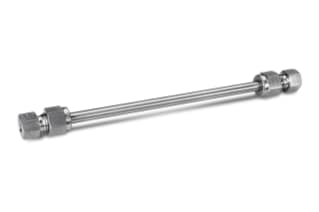
|
Chemistry |
Cyano (CN) |
|
Separation Mode |
Normal-Phase |
|
Particle Substrate |
Silica |
|
pH Range Min |
2 pH |
|
pH Range Max |
8 pH |
|
Maximum Pressure |
6000 psi (415 Bar) |
|
Endcapped |
No |
|
Silanol Activity |
High |
|
Particle Shape |
Spherical |
|
Particle Size |
5 µm |
|
Endfitting Type |
Parker-style |
|
Pore Size |
80 Å |
|
Format |
Column |
|
Surface Area |
220 |
|
System |
HPLC |
|
USP Classification |
L10 |
|
Inner Diameter |
4.6 mm |
|
Length |
150 mm |
|
Carbon Load |
3 % |
|
UNSPSC |
41115709 |
|
Brand |
Spherisorb |
|
Product Type |
Columns |
|
Units per Package |
1 pk |

Spherisorb Cyano (CN) Column, Normal Phase, 80Å, 5 µm, 4.6 mm X 150 mm, 1/pk
The Waters Spherisorb Columns are state-of-the-art analytical columns known for their durability and high efficiency. Their design offers exceptional flexibility in optimizing methods and reducing solvent consumption.
The Spherisorb Cyano (CN), Normal phase, Columns are delivered in 96% heptane with 4% isopropyl alcohol. We highly recommend taking precautions to make sure that none of the mobile phases through the column might cause any precipitation. The Spherisorb Cyano (CN) Normal phase columns are compatible with water and all common organic solvents, provided that solvent miscibility is accounted for.
Equilibrate normal-phase silica columns in the mobile phase. Even very small quantities of water droplets in the mobile phase can have a drastic impact on the activity of normal-phase packings. We recommend that the mobile phase always has the same water content for good reproducibility. Sometimes it can be difficult to completely eliminate water from the mobile phase, where dry mobile phases can take quite some time to equilibrate the column. Hence, we recommend a water content of 50 percent of saturation for most applications.
You can rely on the Waters Spherisorb Cyano (CN) Normal Phase Columns to consistently achieve superb quality and desired results as required for liquid chromatography. Similar to all equipment produced by Waters, these columns are manufactured in dedicated state-of-the-art Waters facilities. All Water manufacturing plants and facilities follow the strictest cGMP, ISO 9002 conditions.
To learn more about the variations of the different analytical columns, such as the Spherisorb Cyano (CN) Column listed here, or to find different products that work with it or even to shop for lab equipment so you can replenish your stock and add to your existing equipment portfolio, you can browse our website and refer to our catalog.
We recommend you also check out the Spherisorb Cyano (CN) Guard Cartridge, 80Å, 5 µm, 4.6 mm X 30 mm, 3/pk. This spherisorb cyano (CN) guard cartridge is designed with the same packing materials as the Spherisorb Cyan (CN) Column, which makes it completely compatible with the column. Secondly, the guard column functions to extend the life of the analytical column by removing any particulate and chemical contaminants from the mobile phase.
What Is The Significance Of A Longer Retention Time?
The amount of time a solute spends inside a column through the test is called ‘Retention Time’. It is the total combined time the solute spends through the stationary and mobile phases in the solvent. As a result, the longer the retention time, the longer the analyte interacts with the stationary phase. Likewise, the stronger their interaction, the more there will be their interaction time.